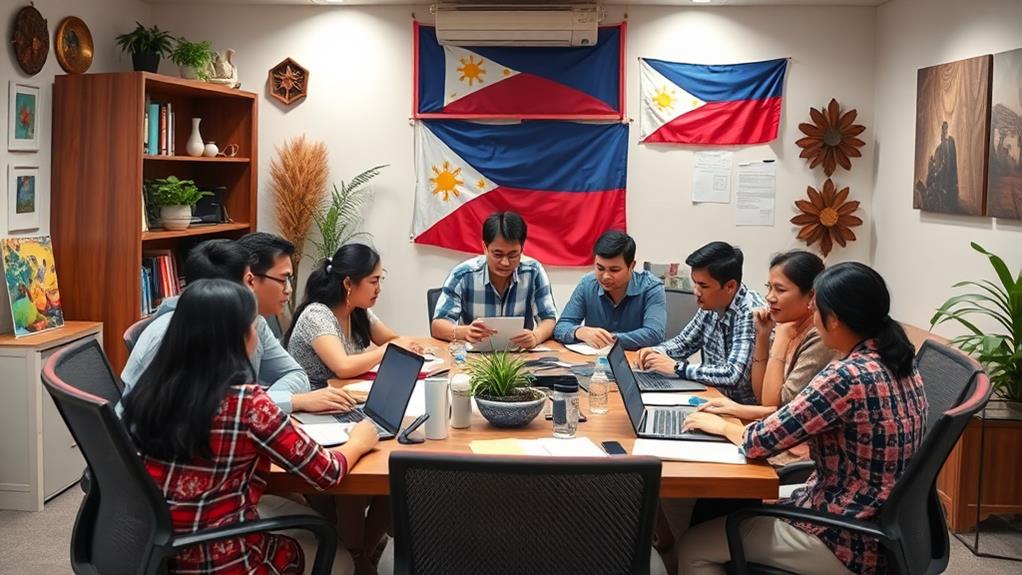Mastering essential Tagalog phrases is crucial for effective communication and building connections with locals in the Philippines. "Kumusta?" (How are you?), "Salamat" (Thank you), and "Magandang umaga" (Good morning) are basic phrases to start with.
When shopping or traveling, knowing "Magkano ito?" (How much is this?) and "Saan ang banyo?" (Where is the bathroom?) will help you navigate everyday situations.
In formal settings, polite expressions like "Po" and "Opo" show respect.
With these essential phrases, you'll be able to engage in everyday conversations and build stronger relationships.
Mastering Basic Tagalog Phrases

Mastering basic Tagalog phrases is essential for effective communication in the Philippines. Kumusta? (How are you?) and Salamat (Thank you) are two fundamental phrases to start with. These common expressions demonstrate respect and friendliness, paving the way for positive interactions with locals.
In Filipino culture, polite expressions like Po and Opo are crucial when speaking to elders or showing respect. These phrases are used to convey deference and courtesy, demonstrating an understanding of cultural norms.
Everyday phrases like Magandang umaga (Good morning) and Paalam (Goodbye) help navigate social situations and make a good impression.
Mastering these basic phrases enables learners to communicate effectively, build confidence, and show respect for the culture. Regular practice is key to improving overall experience when engaging with the Filipino community.
Essential Expressions for Travelers
Mastering Basic Travel Phrases
Knowing the right phrases is crucial when venturing out into the Philippines. "Magkano ito?" (How much is this?) and "Saan ang banyo?" (Where is the bathroom?) are essential phrases to navigate local markets and facilities with ease.
If you need to communicate with locals, ask "Nagsasalita ka ba ng Ingles?" (Do you speak English?) to find someone who speaks your language.
Emergency Situations
In case of emergencies, knowing the right phrases is vital. "Kailangan ko ng doktor" (I need a doctor) and "Tulong!" (Help!) can ensure your safety.
Remember to use these phrases to get the help you need quickly.
Engaging with Locals
Using polite expressions can foster goodwill and positive interactions with locals. "Salamat" (Thank you) and "Walang anuman" (You're welcome) are essential phrases to show your appreciation.
When asking for directions, use "Paano pumunta sa [location]?" (How do I get to [location]?) to explore and navigate unfamiliar areas effectively.
Greeting and Counting
Remember to greet locals with "Magandang umaga" (Good morning), "Magandang hapon" (Good afternoon), and be prepared to count with numbers in Tagalog.
This will help you connect with the local culture and people.
Understanding Filipino Workplace Culture

Respect and Politeness Govern Interactions
In the Filipino workplace, respect and politeness are essential, demonstrated through the use of honorifics like "po" and "opo" in conversations, especially when interacting with elders or superiors.
This emphasis on respect sets the tone for a harmonious work environment.
Teamwork and Collaboration are Valued
Teamwork and collaboration are highly valued in Filipino workplaces. Phrases like "Magkasama tayo" (We're in this together) foster a sense of solidarity among colleagues, promoting a collective effort towards common goals.
Communication often blends Tagalog and English, reflecting adaptability and comfort with both languages, which facilitates understanding among diverse teams.
Celebrating Successes and Showing Gratitude
Celebrating successes and showing gratitude are crucial in Filipino workplaces. Saying "Maraming salamat" (Thank you very much) enhances relationships and morale within teams.
Building Relationships in Tagalog
Building relationships in the Filipino workplace begins with using friendly greetings to initiate conversations and foster rapport. Kumusta? (How are you?) is a common phrase used to start conversations and show interest in others.
Showing respect is essential in Filipino culture, and using terms like po and opo when addressing elders or superiors demonstrates this respect and helps strengthen connections.
Expressing gratitude is vital in building relationships. Maraming salamat (Thank you very much) and Walang anuman (You're welcome) are phrases that can leave a positive impression and deepen relationships.
Engaging in small talk about family or local customs can also enhance connections, as Filipinos value family ties and cultural discussions in building friendships. Additionally, using supportive phrases like Kaya mo yan! (You can do it!) encourages a sense of camaraderie and strengthens bonds within teams and personal relationships.
| Phrases | Meanings |
|---|---|
| Kumusta? | How are you? |
| Maraming salamat | Thank you very much |
| Kaya mo yan! | You can do it! |
| Walang anuman | You're welcome |

Mastering Basic Greetings and Expressions
Navigating everyday conversations is crucial in building relationships in the Filipino workplace. Knowing basic greetings like "Kumusta?" (How are you?) and "Salamat" (Thank you) helps initiate friendly conversations.
Using polite expressions like "Po" and "Opo" when speaking to elders shows respect and fosters goodwill in interactions.
Fostering Collaborative Discussions
Familiarity with essential phrases like "Pwede mo ba akong tulungan?" (Can you help me?) and "Ano sa tingin mo?" (What do you think?) enhances collaborative discussions.
Incorporating expressions of gratitude like "Maraming salamat" (Thank you very much) strengthens relationships and encourages positive communication.
Creating a Welcoming Atmosphere
Engaging in small talk using phrases like "Magandang araw" (Good day) or "Sige" (Okay) creates a welcoming atmosphere and opens doors to deeper conversations.
Cultural Insights and Respect
Showing Respect through Cultural Immersion
By immersing yourself in the local culture, you'll gain a deeper understanding of the Filipino way of life and demonstrate respect for their heritage. This helps build stronger relationships with the locals and makes interactions more meaningful.
Demonstrating Respect
To show respect, use polite forms like po and opo in conversations, especially with elders and those in authority. This acknowledges their status and shows deference.
Building Rapport
Engage in small talk and use greetings like Kumusta? to foster rapport and show interest in building relationships. This helps create a connection with the locals and sets a positive tone for interactions.
Understanding Local Customs
Familiarize yourself with local customs, such as the importance of family and community, to enhance interactions and foster goodwill.
For example, respect for elders and authority figures is deeply ingrained in Filipino culture, so using polite language and showing deference is essential.
Participating in Local Events
Participate in local festivities or cultural events to deepen your understanding of Filipino traditions and create meaningful connections with the community.
This helps you appreciate the local culture and shows your interest in building relationships with the locals.
Can Simple Tagalog Sentences Help Beginners Learn Essential Phrases Faster?
Learning basic communication quickly becomes achievable with consistent practice. Using simple tagalog sentences everyday allows beginners to familiarize themselves with essential phrases and natural conversational flow. Repetition builds confidence, enabling learners to retain vocabulary and grammar more efficiently. Over time, these foundational sentences pave the way for more advanced comprehension and fluency.
Effective Communication in Tagalog

Mastering Tagalog phrases is crucial to effective communication in the Philippines. When interacting with locals, using polite markers like po and opo shows respect, especially when speaking to elders or in formal settings.
Everyday Interactions
To foster positive exchanges, familiarize yourself with essential words and phrases. Salamat (Thank you) is a must-know phrase, and responding with Walang anuman (You're welcome) shows appreciation.
When asking about someone's well-being, say Kumusta? (How are you?), and respond with Magandang araw (Good day) to show enthusiasm.
Responses and Small Talk
To encourage collaborative dialogue, ask questions like Pwede mo ba akong tulungan? (Can you help me?) and May katanungan ka ba? (Do you have any questions?).
When apologizing, use Pasensya na (Sorry) to show remorse. In casual settings, use magandang gabi (Good evening) or po ako (I'm good) to build relationships and demonstrate cultural appreciation.
Frequently Asked Questions
What Is the Easiest Language to Learn if You Speak Tagalog?
Spanish is the easiest language to learn for Tagalog speakers. This is because around 20% of Spanish vocabulary is borrowed from Tagalog, making it easier to recognize and understand new words.
Additionally, many Spanish loanwords are already part of daily conversation in Tagalog, providing a familiar cultural context.
To learn Spanish quickly, take advantage of abundant learning resources and language immersion opportunities.
Focus on mastering pronunciation tips, such as rolling your "r"s, and you'll be speaking like a native in no time.
Can You Learn Tagalog in 3 Months?
Yes, you can learn Tagalog in 3 months with dedication and the right approach. This can be achieved through language immersion, which involves surrounding yourself with the language as much as possible.
To do this, commit to daily practice of at least 30 minutes to reinforce new skills.
Utilize online resources such as language-learning apps and websites that offer pronunciation tips and cultural context. For example, language-learning apps like Duolingo and Rosetta Stone provide interactive lessons and exercises to help you learn Tagalog.
Websites like Tagalog Lang and Learn Tagalog offer pronunciation guides and cultural insights to enhance your learning experience.
Focus on speaking and listening to improve your pronunciation. Listen to native speakers and practice speaking with them as much as possible. You can do this by finding a language exchange partner or watching Tagalog videos and TV shows with English subtitles.
With consistent effort, you'll be conversing in Tagalog in no time! By following these steps and staying committed to your daily practice, you can achieve your goal of learning Tagalog in just 3 months.
How to Start Learning Tagalog?
Start Learning Tagalog with the Right Resources
To begin, explore language resources such as language learning apps like Duolingo, online courses like TagalogPod101, and language exchange groups like Tandem. These resources provide a solid foundation for learning Tagalog.
Master Pronunciation from the Start
Focus on pronunciation tips to get it right from the beginning. For instance, learn the correct pronunciation of the unique sounds in Tagalog, such as the "ng" sound in "ngiti" (smile) and the "r" sound in "radyo" (radio).
Effective Practice Methods
Practice methods like labeling household items with their Tagalog names, such as "kama" (bed) and "mesa" (table), help to associate words with objects.
Watching Filipino media, like TV shows and movies with English subtitles, also improves listening and comprehension skills.
Cultural Immersion and Daily Practice
Cultural immersion is key to learning Tagalog. Engage with native speakers through language exchange groups or online forums to practice speaking and listening.
Make it a habit to practice speaking daily, even if it's just for a few minutes, to improve your speaking skills.
Dedication and Consistency
With dedication and the right resources, you'll be speaking Tagalog in no time! Set aside time each day to practice, and you'll be well on your way to becoming proficient in Tagalog.
How Many Words Do You Need to Know to Be Fluent in Tagalog?
1,000 to 2,000 words are required to achieve fluency in Tagalog, allowing for basic communication in everyday situations. To build a strong foundation, focus on learning high-frequency words and phrases first. For instance, start with common greetings like "Kumusta?" (how are you?) and "Salamat" (thank you).
Regular daily practice is essential to enhance vocabulary acquisition. Practice for at least 15-30 minutes daily to accelerate your progress. Immerse yourself in the language by listening to Tagalog music, watching Filipino movies or TV shows, or speaking with native speakers.
Understanding the cultural context is also crucial. Learn about Filipino customs and traditions, such as the importance of respect for elders and the concept of "bayanihan" (communal unity). This will help you better understand the language and communicate more effectively.
Utilize language resources, such as language learning apps or online courses, to supplement your learning. Converse with native speakers at least once a week to improve your pronunciation and comprehension.
With consistent effort, you'll be well on your way to becoming fluent in Tagalog.